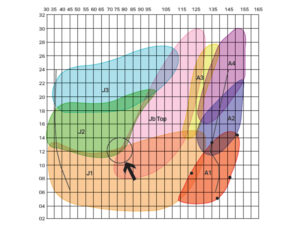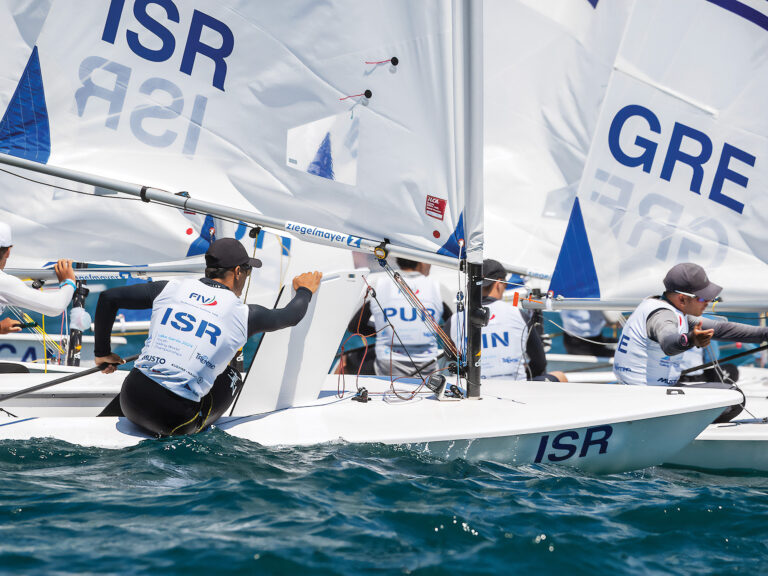
Jan06MMT
The offset leg presents a number of unique opportunities to pass, but the key is to consider what you’re trying to achieve, tactically, in the first half of the downwind leg. The rounding and your positioning immediately after the rounding will dictate your position farther down the run.
The basic concepts for the offset mark are:
1. If you want to jibe immediately, maximize the gap between you and the mark. In other words, use the offset mark as part of your turn into the jibe.
2. If you want to extend straight after rounding, position the boat no lower or no higher than the boat on your stern-in particular, no lower. Also, don’t tempt the boat behind to sail high by setting up low after the offset mark.
OK, let’s get to our sequence, which shows International One-Design No. 59 with a classic case of “tunnel vision,” while racing at the Worlds last year in Tønsberg, Norway.
In photo 1 we can see the bowman on No. 59 standing up, looking at the overlap, and I’m sure the helmsman on No. 50 is saying, “There’s no way you’re getting room.” Meanwhile life on No. 33 (yellow hull) is all good. They’re being patient and watching things develop ahead of them.
In photo 2, No. 50 and No. 59 have forgotten the most basic part of the mark rounding maneuver-turning down at the mark. So focused on each other, they sail right past it. No. 33 is approaching perfectly-entering the mark at the proper angle, about 1.5 boatlengths high, so their turn at the mark is tight. With this move they’re instantly on the inside and in complete control. No. 59 is at huge risk of losing second because they’re now controlled by No. 33 to leeward and No. 50 to windward.
In photo 3, we see sloppy crew work on No. 33 and No. 50. At this point, I’m sure the helmsman of No. 59 is cringing. His obsession with getting the inside at the offset has left him as the meat in a spinnaker-less sandwich. No thanks, I’m not hungry!
Consider for a moment what would have happened if, five boatlengths earlier, the helmsman of No. 59 had of said, “There’s no way we’re getting the overlap, let’s focus on the fastest maneuver.” They would’ve escaped to leeward of 50, carrying a full kite, with the option to jibe. It’s too late now.
In photo 4, No. 33 is now getting the kite going-still not great-and No. 50 is still struggling.
In photo 5, kudos to the crew of No. 59-crisp spinnaker set. Now, if only the guy at the back of the boat had been as sharp as the guy at the front. His tunnel vision has left them stuck in the middle with nowhere to go, with no control of their destiny. They’re completely at the mercy of the windward and leeward boats. My advice to alleviate this tunnel vision is to focus on the first 10 boatlengths after the offset mark, not the last two into the offset. Our friends on No. 59, while getting the overlap they so desired, ultimately got more than they bargained for. The entire downwind leg would’ve been easier if there was a quick conversation about what they wanted out of the offset.
If you want to jibe, a tight rounding and low exit is key. If you want to extend, hold a normal angle, or one slightly high, to defend your position in traffic.









